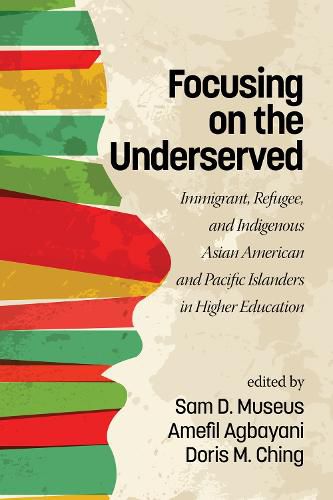Readings Newsletter
Become a Readings Member to make your shopping experience even easier.
Sign in or sign up for free!
You’re not far away from qualifying for FREE standard shipping within Australia
You’ve qualified for FREE standard shipping within Australia
The cart is loading…






This title is printed to order. This book may have been self-published. If so, we cannot guarantee the quality of the content. In the main most books will have gone through the editing process however some may not. We therefore suggest that you be aware of this before ordering this book. If in doubt check either the author or publisher’s details as we are unable to accept any returns unless they are faulty. Please contact us if you have any questions.
Recent discussions and dissemination of information regarding the rapid growth of Asian Americans and Pacific Islanders (AAPI) across our nation are creating some awareness among administrators and educators in higher education institutions regarding the extensive diversity of AAPIs, the struggles of some AAPI populations in pursuing and succeeding in higher education, and the lack of support for their educational success. National discourse on AAPIs among educators, policymakers and AAPI communities underscores the need for more research-including more relevant research-that can inform policy and practice that will enhance educational opportunities for AAPIs who are underserved in higher education.
The book focuses on diverse topics, many of which do not appear in the current literature. The chapters are authored by an array of distinguished and emerging scholars and professionals at various universities and colleges across the nation. The authors, whose insights are invaluable in understanding the diverse issues and characteristics that affect the educational success of underserved AAPI students, and they represent the ethnicities and cultures of Cambodian, Chinese, Guamanian/Chamorro, Filipino, Hispanic, Hmong, Japanese, Korean, Laotian, Native Hawaiian, Okinawan, Samoan, Vietnamese, and multiracial Americans. The authors not only integrate theoretical concepts, statistical analyses, and historical events, but they also merge theory and practice to advocate for social justice for AAPIs and other underrepresented and underserved ethnic minority groups in higher education.
$9.00 standard shipping within Australia
FREE standard shipping within Australia for orders over $100.00
Express & International shipping calculated at checkout
This title is printed to order. This book may have been self-published. If so, we cannot guarantee the quality of the content. In the main most books will have gone through the editing process however some may not. We therefore suggest that you be aware of this before ordering this book. If in doubt check either the author or publisher’s details as we are unable to accept any returns unless they are faulty. Please contact us if you have any questions.
Recent discussions and dissemination of information regarding the rapid growth of Asian Americans and Pacific Islanders (AAPI) across our nation are creating some awareness among administrators and educators in higher education institutions regarding the extensive diversity of AAPIs, the struggles of some AAPI populations in pursuing and succeeding in higher education, and the lack of support for their educational success. National discourse on AAPIs among educators, policymakers and AAPI communities underscores the need for more research-including more relevant research-that can inform policy and practice that will enhance educational opportunities for AAPIs who are underserved in higher education.
The book focuses on diverse topics, many of which do not appear in the current literature. The chapters are authored by an array of distinguished and emerging scholars and professionals at various universities and colleges across the nation. The authors, whose insights are invaluable in understanding the diverse issues and characteristics that affect the educational success of underserved AAPI students, and they represent the ethnicities and cultures of Cambodian, Chinese, Guamanian/Chamorro, Filipino, Hispanic, Hmong, Japanese, Korean, Laotian, Native Hawaiian, Okinawan, Samoan, Vietnamese, and multiracial Americans. The authors not only integrate theoretical concepts, statistical analyses, and historical events, but they also merge theory and practice to advocate for social justice for AAPIs and other underrepresented and underserved ethnic minority groups in higher education.